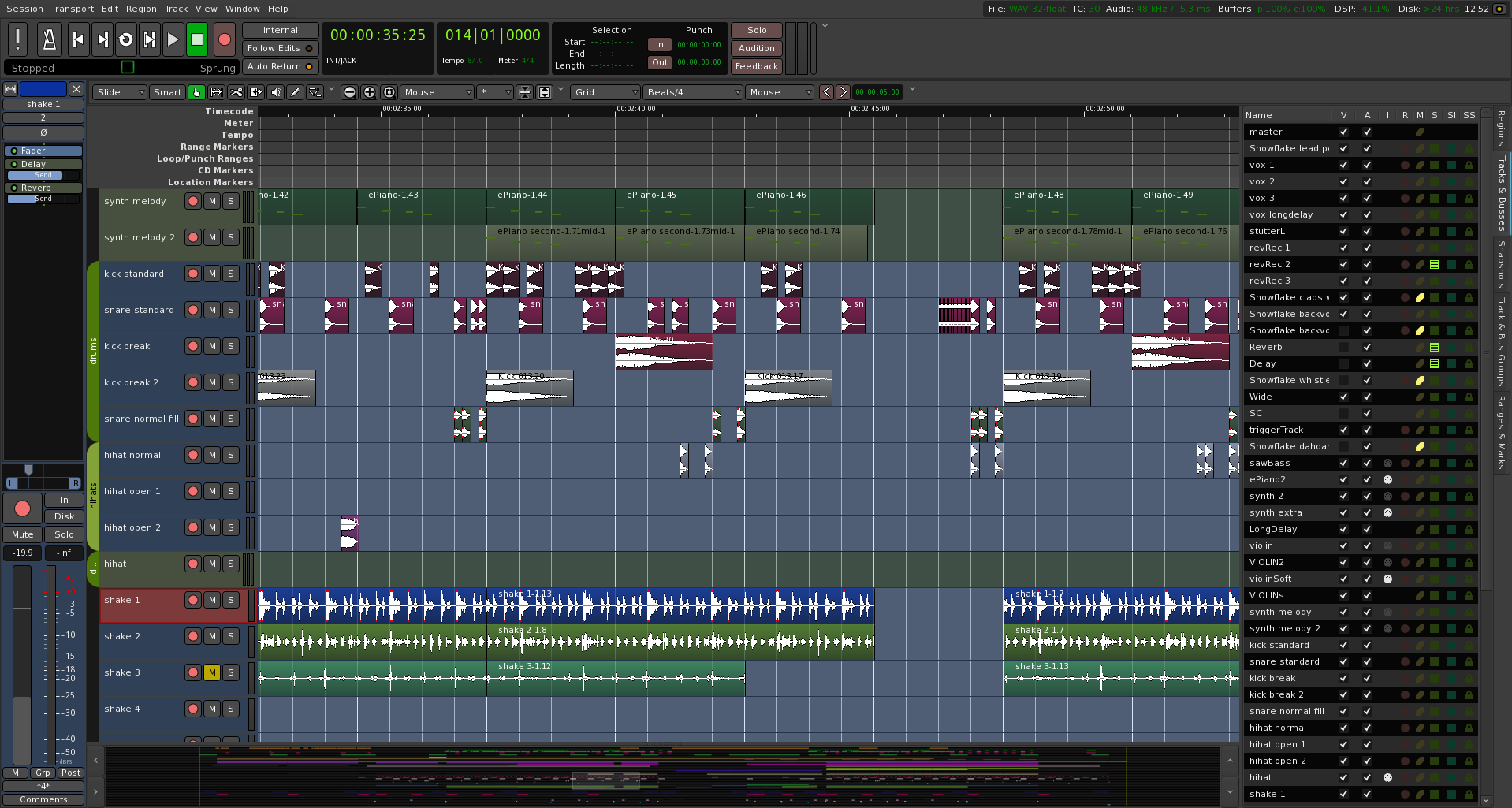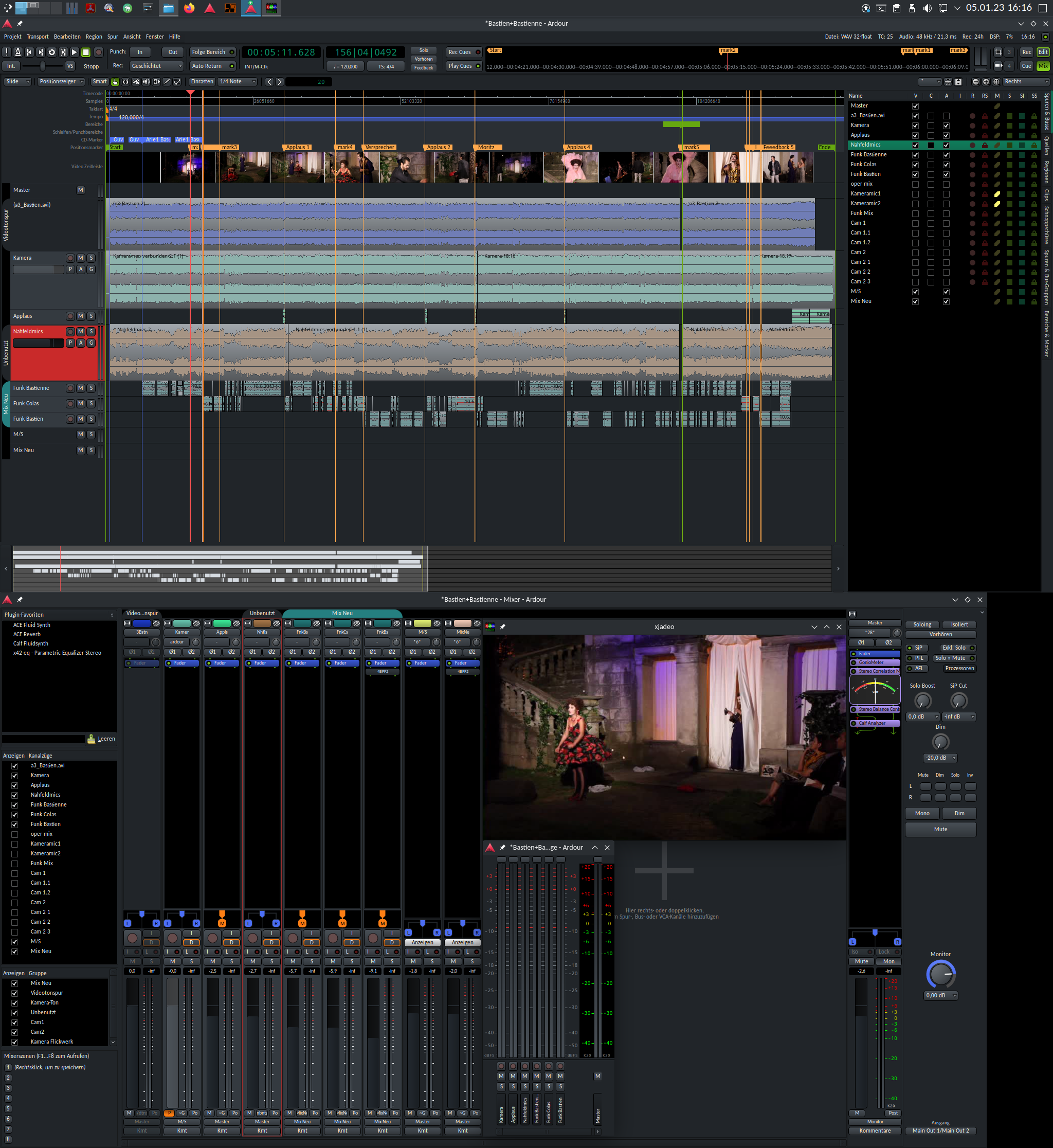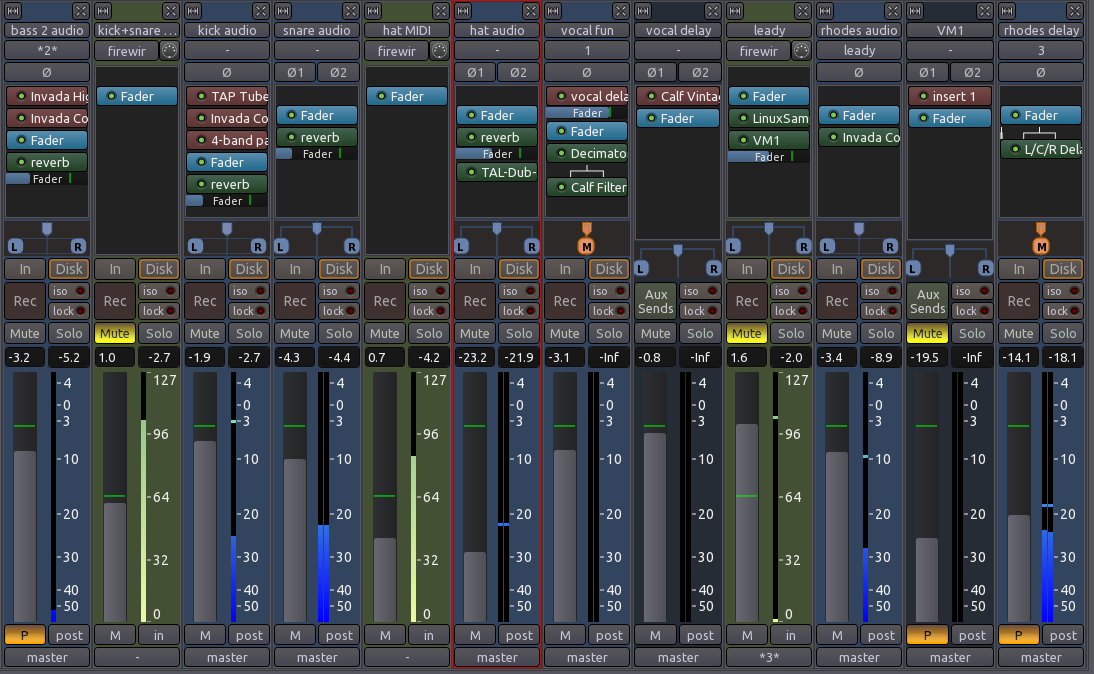Recording

Hardware
Pick your audio interface based on your needs and budget. If your OS supports it, Ardour can use it. PCI, USB, Firewire interfaces, along with the option to use network audio too.
Flexible Recording
True tape-style transport allows any combination of master record and individual track arming at any time; no prior setup is needed. Per-track setting of layered or non-layered recording modes. Flexible input monitoring options can handle it automatically or allow you to take control with individual monitor buttons. Punch in/out points can be set in a multitude of ways, and alternatively loop playback and recording is an option. Stop&Forget feature allows you to cancel a recording pass and recover the disk space instantly. Furthermore record points can be feely chosen in the signal flow, allowing for wet recording.


Unlimited Multichannel Tracks
No limits on number of tracks, buses, plugins, inserts, or sends. Tracks may consist of overlapping layered regions, non-overlapping regions, or true destructive (single-file) regions. Tracks may be mono, stereo or multichannel. Flexible plugin panner architecture allows sensible panning of multichannel tracks into buses. Multichannel tracks also have individual outputs so a multichannel track can be routed to separate mixer strips for panning & processing, while still retaining the benefits of one-touch recording and editing.
Editing
Non-destructive, non-linear editing with unlimited undo/redo, even across editing sessions (reload and undo your changes from last time).
All editing is in-window: no switching to piano roll or other dedicated dialogs/displays for specialized operations.
Overlapping regions, opaque regions, transparent regions: work the way you think is best.
Vertical stacking mode for displaying overlapping regions
Strip silence, push-pull trimming, Rhythm Ferret for transient and note onset-based editing.
Soundtracks
- Import a single video and optionally extract the soundtrack from it.
- Display a frame-by-frame (thumbnail) timeline of the video.
- Use a separate video-monitor window, or full-screen display, of the imported video in sync with any of the available Ardour timecode sources.
- Lock audio and MIDI regions to the video and move regions with the video at video-frame granularity.
- Export the video, cut start/end, add blank frames and/or mux it with the soundtrack of the current-session.
Modular setup is modular: configure your system in different ways, including:
- One machine: all video decoding, video monitoring and Ardour audio
- Two machines: separate video-monitor and Ardour
- Three machines: separate video-server (for timeline decoding and file-archive), dedicated video-monitor and Ardour
Mixing
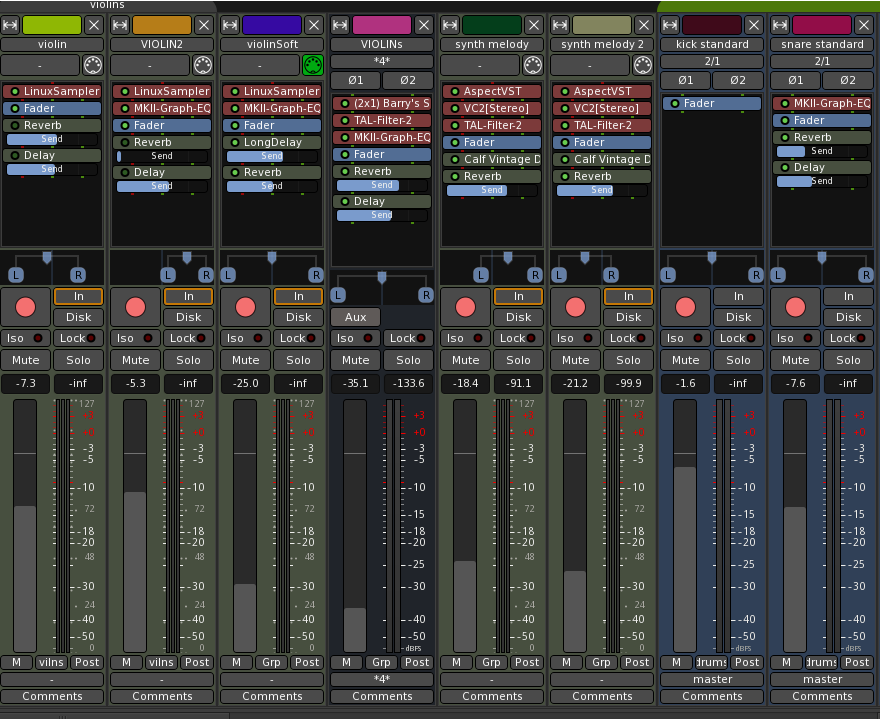
Routing
Route anything to anywhere (for more than ten years!). Matrix-style patching/routing. Connect Ardour tracks or busses to hardware, each other, other applications, the network ... input, output, sends, inserts, returns all managed in the same way.


Solo/Listen Model
Sophisticated solo model includes listen (AFL/PFL) as well as solo-in-place. Continuously variable solo-in-front control. Solo Isolate and Solo Lock modes per mixer strip.
Monitor Section
Optional monitor section, complete with dim, cut, mute controls per channel and globally. Outputs are indepedent from the master bus outputs.
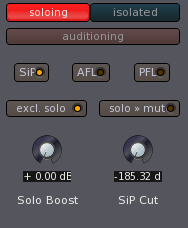

Inline Plugin Control
Display plugin parameter controls directly inline in the mixer strip, without opening plugin editors. Bypass plugins. Drag-n-drop plugins between tracks (and busses), retaining settings. Create track/bus templates complete with plugin chains and settings predefined.
Panning
Multiple panners available, including (for stereo) "home stereo balance" and true Stereo panning with independent (coupled) width and position.


Automation
Sample accurate automation for everything. Write + Touch modes. Record control movement or enter automation data with the mouse. Full copy-n-paste. Automation data can move with regions or belong to a track.
Mix Groups
Mix groups allow grouped control of basic track properties like record enable, solo, mute. But not just the basics: share selection (editing) behaviour, colors, monitoring state. Hide/show groups en-masse. Sub-group in a couple of mouse clicks. Route groups via dedicated aux busses. Fit group to window.

Plugins
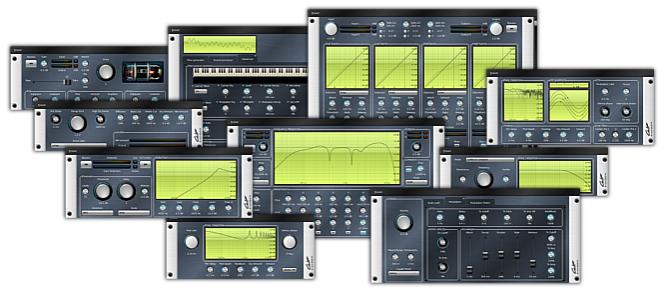
Hundreds of no-cost plugins in LV2, native VST and AudioUnit formats on all platforms. On Linux install LV2 plugins with your system software manager.
AudioUnit (AU) plugin support on OS X, allowing use of all effects and instruments plugins from Waves, u-he, iZotope, PSP, Stillwell and many, many other plugin manufacturers.
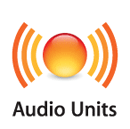

VST plugin support on Windows allows access to hundreds or thousands of plugins from dozens of manufacturers. Linux VST support provides access to High quality proprietary plugins on Linux from Loomer, Pianoteq/Modartt. Excellent open source plugins from Distrho and others.
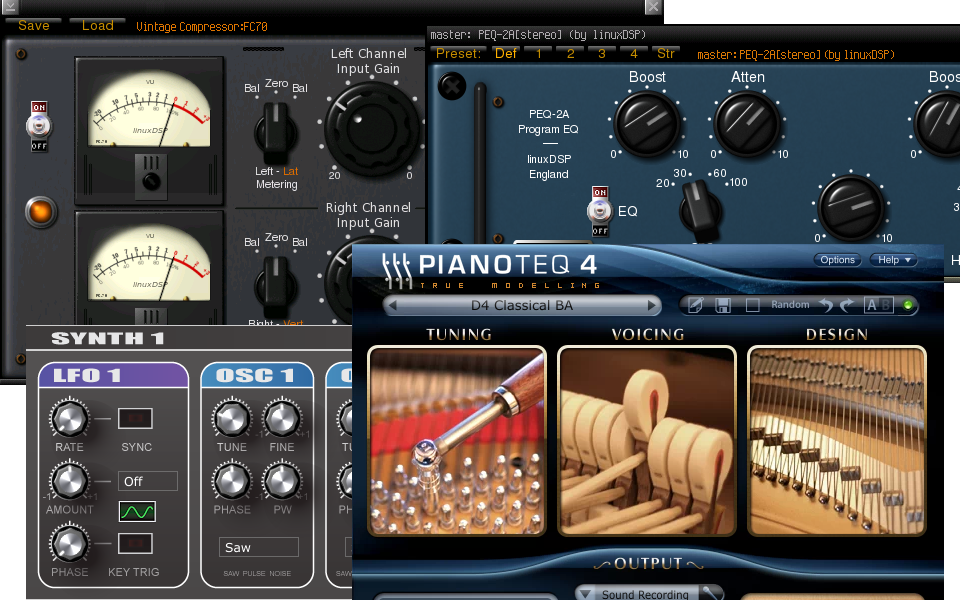
Exporting
Export to many different data and file formats, including but not limited to WAV, AIFF, CAF, BWF, FLAC, Ogg/Vorbis, MP3.
Multichannel (>2) file exports. Any number of channels. Whatever you need.
Export multiple formats and sample rates at once.
Add, Edit and manage export format specifications directly from the export dialog.
Stem Exports ("one file per track") of one or many tracks.
Create CUE and TOC files for use by CD mastering applications and companies.
Faster-than-realtime (the default) or real-time export (the latter allows for hardware or software inserts during export).
Post-export analysis, include loudness graphing and frequency analysis.
Third party tools such as AATranslator to convert your entire session for use with other DAWs including Logic, ProTools, Cubase and more.
Specifications
Your CPU, audio interface and disk system are the only limits to what you can do with Ardour.
| Feature | Ardour Limit | Limiting System Features |
|---|---|---|
| Number of tracks | No Limit | Disk system, CPU |
| Number of busses | No Limit | CPU |
| Sample Rate | No Limit | audio interface |
| Channels | No Limit | audio interface, CPU |
| Sends/Inserts Per Track | No Limit | CPU |
| Plugins Per Track | No Limit | CPU |
| Latency | No Limit | Hardware, BIOS, OS kernel, video drivers, Wifi drivers. |
As a general rule of thumb, most modern computers will be able to handle 24 tracks with moderate plugin processing (some EQ and other less intensive processing per track, plus compression and reverb on busses) without much of a problem as long as your latency settings are not too demanding.

